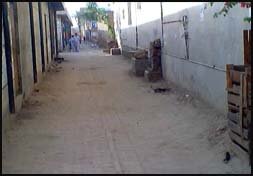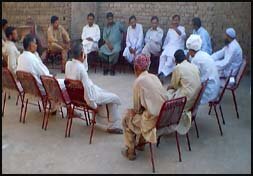

IT Department of Anjuman Samaji Behbood © 2007. All rights reserved. 40-A, Main Bazar Dhuddiwala Faisalabad 38060 Pakistan , Tel : 009241-8713431 Mobile: 00923457857489
| How we Work |
| Where we work |
| Vision and Mission |
| Members Area |
| Sanitation Problems |
| Impact of our work |
| The need |
• This Component Sharing development model is
included in the National Water and Sanitation
policy of the Government of Pakistan.
• Environmental condition, economic activities and
value of properties has increased.
• Neighborhood disputes over water
and sanitation are now a history.
• This is the outcome of demonstration effect of
the lane with underground piped water and sewerage
which reclaimed space for children’s play.
ASB ELEMENTS OF SUCCESS
. Necessities of people justify it.
· Scanty resources and unlimited wants, which increases with population growth, provides basis to initiate this process.
· Cost Effectiveness with appropriate technology and standards supported with OPP thumb rules procedures.
· Free from complexities of bureaucratic procedures and channels.
· Making it possible for the people to work for themselves, use their own resources and benefit from it.
· Government inability to provide services to address people’s needs on time.
· Time saving is one of the component.
· Awareness has come to the government circle about successful community participation model.
· Sense of ownership.
· Spiritual belonging, sincerity, dedication and devotion have brought a behaviour change among GOs and other stakeholders.
· Interaction with government organisations (GOs) for development of external systems for water supply, sewerage and social sectors interventions has been improved.
· As a result of the strenuous efforts, the government has been convinced that ASB approach is viable, therefore, it can work in the government sector.
· The local administration often visits ASB projects and evaluates performance keeping in view the pre and post situations of these projects for replication at scale.
· Legal protection is being provided to institutionalise ASB modality of development. This was possible due to visible successes of ASB, which has been recognised by the GOs.
· ASB has been given representation in the district development committee and other forums of GOs to voice its successes. Consequently, ASB’s access to GO’s resources has been enhanced. It is now possible to utilise the available government funding for external development in a planned manner.
· ASB’s approach has opened a way to build and sustain close co-ordination and cohesiveness between GOs and NGOs.
· Public has accepted the role of ASB, to address their issues in the field of integrated development.
· As a successful development model, ASB’s model is being extended to rural areas as well. The close co- ordination between GOs and NGOs has improved relationships with administration.
· In order to plan development in a systematic way, proper documentation of the available facilities, gaps and future needs are required to be made. It will help to prepare and implement effective integrated development plans.
SOCIAL IMPACTS
· Silent communities started thinking of their own betterment ,Individual shaped into organization.
· The people felt empowered towards addressing their issues & become better off both in knowledge & in life style, poor people cease to wait for Govt., promises.
· The idea of component sharing in development be came acceptable / viable, Sense of ownership of infrastructure & its subsequent look after development, Skilled labour generated.
· More responsibility is paying towards for civic services instead of considering them free commodities.
· ASB’s approach has opened a way to build a sustainable co-ordination and Cohesiveness. As a successfull development model for Urban and Rural areas.
THE DEVOLUTION
· Power plan strives for partnership between Govt. and community at grass root level.
· ASB Component Sharing Model evolved in the Water & Sanitation programme and demonstrated this partnership strengthening the Sense of ownership through Flexible modes of management and change in policy.
· Component Sharing development model is only the solution.
· In this way Government will be ensure Transparency, Accountability, Good Governance & able to reduce Tax net.
· Community participation is not the problem.
· Government and professionals participation is needed in the people’s work.
· Community initiatives need to be respected, accepted and supported by professionals and Government.

